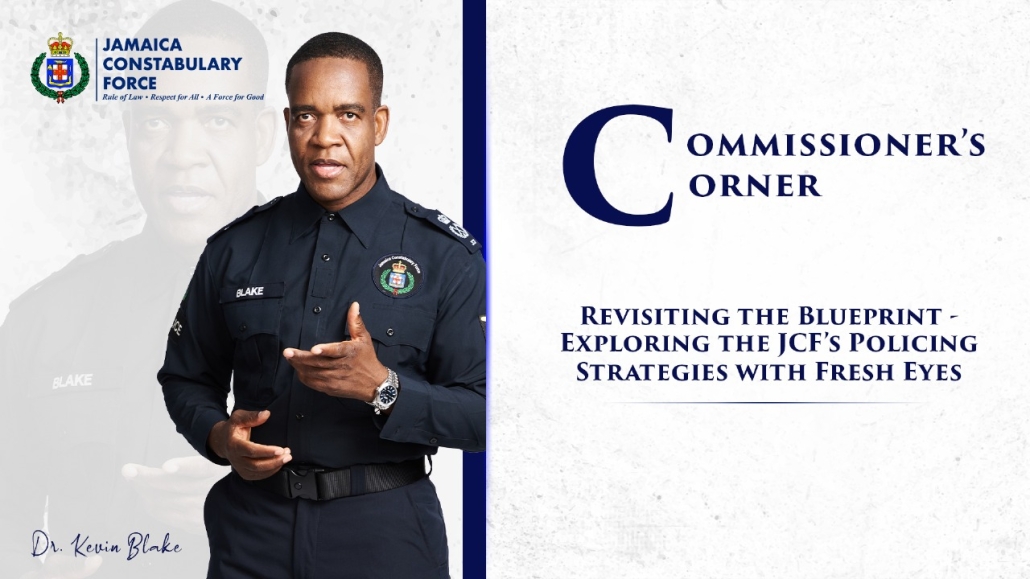
Revisiting the Blueprint –
Exploring the JCF’s Policing Strategies with Fresh Eyes
In the world of public institutions, one of the most common and consequential mistakes is to forget why certain systems, policies or programmes were created in the first place. In policing, the stakes for such amnesia are particularly high.
This is why Police Commissioner Dr Kevin Blake’s latest reflection in the weekly Force Orders goes beyond a nostalgic nod to the past, to a radical act of institutional accountability. With disarming clarity, he is calling the Jamaica Constabulary Force (JCF) to pause; not to stand still, but to look again. “The strength of any institution lies in evolving without forgetting,” he writes. “And so, let us never forget that we owe our progress to the architects of the past.”
At a time when public sector leadership is so often defined by short-termism and administrative churn, Dr Blake’s column is a compelling example of a different kind of leadership; one that isn’t afraid to interrogate its own systems, to understand their roots, and to recalibrate them with intention.
Relearning What We Know
The Commissioner begins his column with a timely reminder about institutional memory, triggered by the demands of the 2025 hurricane season. It is, he argues, not enough to have a plan. We must remember why the plan exists in the first place.
This mindset frames his reflection on the evolution of some of the JCF’s most enduring policing strategies; strategies that continue to shape public safety today. One such example is the Proactive Investigation Unit (PIU), which emerged from the earlier Street Crimes Unit under former Commissioner Owen Ellington. It was designed to intercept crimes-for-profit, which are often precursors to violent offences. “The unit was to focus on those antecedents to violent crimes, … the tackling of ‘crimes for profit and any other criminal activities that would lead to violent conflicts generally, and more specifically murders,” Dr Blake recalls.
This origin story is a necessary provocation. How many of our current strategies still carry the DNA of their original design? And how many have drifted from their purpose under the pressures of daily operations, resource constraints, or changes in leadership?
In recounting the re-establishment of the Area Fugitive Apprehension Teams (AFAT), Dr Blake reveals how strategic design must remain responsive to the problem it seeks to solve. The teams were born out of necessity—violent criminals, often highly mobile and networked, cannot be contained within divisional borders. “These individuals wanted for violent crimes are not confined by geographic divisional boundaries…. Hence the Area Fugitive Apprehension Teams,” the Commissioner explains.
This is strategy meeting structural reform. It’s a recognition that effective policing must be agile enough to mirror the complexity of the criminal networks it confronts. It also requires a leadership ethos that refuses to settle for inertia.
A Culture of Remembering
What Dr Blake is advocating is, in essence, a culture of remembering: not in the romantic sense, but as a discipline of reflection that holds systems accountable to their intended purpose. This principle extends beyond the AFAT and PIU. He signals future explorations into the Violence Attribution and Assessment Policy, the 80/20 strategy, and other foundational tools—treating these not as relics, but as living frameworks. “When we speak of building on the legacy of those before us … we are also referring to the use of these various strategies, policies and formations to advance our most recent Focused Deterrent Strategy,” he writes.
By anchoring new initiatives in historical insight, the High Command is charting a course that neither romanticises the past nor discards it. Instead, it engages with the past in order to sharpen the present.
This approach has profound implications, indeed, for the JCF, but for all public institutions grappling with the demands of reform, trust-building, and performance in a turbulent global context. When institutions revisit their blueprints with clarity and courage, they model a kind of maturity that is rare in bureaucratic life.
To take a fresh look at established systems is to ask hard questions: Are we solving the same problems today? Do we understand what success looks like? Are our tools still fit for purpose? In a landscape where public trust is fragile and legitimacy must be earned daily, these are not academic queries; they are moral ones.
The column ends with a note of honour to past leaders, but it is more than tribute. It is an invitation. “Just ask yourself the question,” Dr Blake advises, “what problem was this policy or strategy sought to solve?”
This question should be on the desk of every public manager, every department head, every aspiring leader in law enforcement. Because when the answers become unclear, it’s time to look again. And perhaps, as Dr Blake subtly suggests, that second look might just be the beginning of real transformation.







